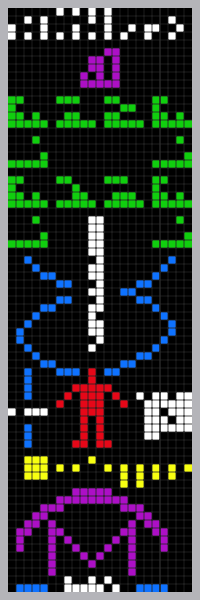
There’s a longstanding argument about whether – if alien civilizations do exist beyond our Earth – we should make our presence known to them. That argument has been going on since at least 1974, when the Arecibo Interstellar Message became the first message from Earth intentionally transmitted outward. Whether we should or should not transmit our whereabouts in the galaxy is an interesting question, and a question separate from the issue of how to do it. But the how of it is interesting, too. On November 4, 2018, Massachusetts Institute of Technology (MIT) announced that one of its graduate students has figured out a novel approach, using lasers. MIT explained in a statement:
If extraterrestrial intelligence exists somewhere in our galaxy, a new MIT study proposes that laser technology on Earth could, in principle, be fashioned into something of a planetary porch light — a beacon strong enough to attract attention from as far as 20,000 light years away.
Graduate student James Clark is the author of what he calls a “feasibility study.” This student-led study, surprisingly, has now been published in the peer-reviewed Astrophysical Journal. The findings suggest that if a high-powered 1- to 2-megawatt laser were focused through a massive 30- to 45-meter telescope and aimed out into space, the combination would produce a beam of infrared radiation strong enough to stand out from the sun’s energy. MIT said:
Such a signal could be detectable by alien astronomers performing a cursory survey of our section of the Milky Way — especially if those astronomers live in nearby systems, such as around Proxima Centauri, the nearest star to Earth, or TRAPPIST-1, a star about 40 light-years away that hosts seven exoplanets, three of which are potentially habitable.
If the signal is spotted from either of these nearby systems, the study finds, the same megawatt laser could be used to send a brief message in the form of pulses similar to Morse code.

Clark began looking into the idea of using lasers to signal extraterrestrials as part of a project for a course at MIT called Spacecraft and Aircraft Sensors and Instrumentation, taught by Clark’s advisor Kerri Cahoy. Clark said:
I wanted to see if I could take the kinds of telescopes and lasers that we’re building today, and make a detectable beacon out of them.
MIT explained:
He started with a simple conceptual design involving a large infrared laser and a telescope through which to further focus the laser’s intensity. His aim was to produce an infrared signal that was at least 10 times greater than the sun’s natural variation of infrared emissions. Such an intense signal, he reasoned, would be enough to stand out against the sun’s own infrared signal, in any ‘cursory survey by an extraterrestrial intelligence.’
He analyzed combinations of lasers and telescopes of various wattage and size, and found that a 2-megawatt laser, pointed through a 30-meter telescope, could produce a signal strong enough to be easily detectable by astronomers in Proxima Centauri b, a planet that orbits our closest star, 4 light-years away. Similarly, a 1-megawatt laser, directed through a 45-meter telescope, would generate a clear signal in any survey conducted by astronomers within the TRAPPIST-1 planetary system, about 40 light-years away. Either setup, he estimated, could produce a generally detectable signal from up to 20,000 light-years away.
Both scenarios would require laser and telescope technology that has either already been developed, or is within practical reach. For instance, Clark calculated that the required laser power of 1 to 2 megawatts is equivalent to that of the U.S. Air Force’s Airborne Laser, a now-defunct megawatt laser that was meant to fly aboard a military jet for the purpose of shooting ballistic missiles out of the sky. He also found that while a 30-meter telescope considerably dwarfs any existing observatory on Earth today, there are plans to build such massive telescopes in the near future, including the 24-meter Giant Magellan Telescope and the 39-meter European Extremely Large Telescope, both of which are currently under construction in Chile.
Clark envisions that, like these massive observatories, a laser beacon should be built atop a mountain, to minimize the amount of atmosphere the laser would have to penetrate before beaming out into space.
For safety’s sake – to prevent any potential for damage to people’s vision, or spacecraft cameras, from wandering into the beam of such a powerful laser – Clark also recommended building his laser on the far side of the moon. He added:
In general, this was a feasibility study. Whether or not this is a good idea, that’s a discussion for future work.
What do you think? If the technical and safety problems could be solved – and assuming this idea would work in actuality – should we be signaling our presence to alien civilizations? Tell us what you think, in the comments below.
Bottom line: An MIT grad student has a published a new study in one of astronomy’s most prestigious journals about using existing laser technology to signal our presence to possible extraterrestrial civilizations on distant worlds. Good idea?
Source: Optical Detection of Lasers with Near-term Technology at Interstellar Distances
The 2019 lunar calendars are here! Order yours before they’re gone. Makes a great gift.











